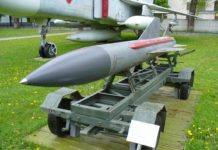Russia military authorities are currently choosing a new automatic rifle for Ratnik combat outfit. They have to choose from models of Kalashnikov corporation and Kovrov-based ZiD.
Farewell, kalashnikov, hello, kalashnikov
By the end of the year, Russian military may choose an automatic rifle that will become a part of the new outfit Ratnik. Models of two manufacturers – Kalashnikov corporation (AK-12, AK-15) and Kovrov-based ZiD (A545 and A762) are currently undergoing tests in the troops). It is possible that both automatic rifles will finally be adopted for service.
Ratnik outfit or “future soldier kit” is positioned as one of the most ambitious projects for modernization of the Russian army. The kit (presented for the first time in 2011) that should improve efficiency and survivability of a soldier on a battlefield includes a few tens of elements: attack means – weapons, aiming systems, defense means – bulletproof jacket, helmet, glasses etc, observation and communication means and life support means up to such trifles as universal multitool and tactical watch.
It was reported that in 2012 Ratnik passed through tests in the troops and after that elements of the system were adopted or service. At this point it is necessary to explain that unified Ratnik kit does not exist and outfits for various branches of the Armed Forces have their own specialty. Even separate military specialties, for example, special units have their own outfits. The nomenclature of elements of Ratnik is so big that it will hardly be adopted in full scope. So far, this or that element is adopted by orders of the Defense Minister.
Probably the most dramatic part of the project is choice of a new automatic rifle to replace AK-74M that is in service. The military wish to adopt the “weapon of the 21st century” in two calibers: 5.45 mm and 7.62 mm. This would be logical because after transition of the Soviet army to the low-impulse cartridge of 5.45×39 mm in 1974 some units like reconnaissance ones, special units etc kept using weapons for the cartridge of 7.62×39 mm.
Two manufacturers struggle for the right to arm “the future soldier”: Kalashnikov corporation and Kovrov-based plant named after Degtyarev (ZiD). Along with this, both companies actually offer repackaging of old systems. Thus, ZiD presented the product rejected by the military last century: AEK-971 with balanced automatics. This meant that a special balancer was included into the design of the breech block that was equal to it in weight and connected with it by a hog wheel. During the shot the balancer moves in the direction opposite to the breech block and compensates for the impulse from its hit on the rear wall of the barrel extension seriously reducing the jumping of the weapon. As a result, AEK is 15-20% superior to AK-74 according to accuracy of firing of bursts of rounds.
АЕК-971 was created at the Kovrov mechanical plant (KMZ) for Abakan contest announced by the Defense Ministry in 1978. Then solutions used in this model seemed unjustified to the military and the automatic rifle from Kovrov did not even make it to the final round of the contest. Nonetheless, it did not sink into oblivion but was modernized in the 1990s and was produced in small series for needs of the Interior Ministry and other security agencies. This continued until 2006 when production of weapons at KMZ was stopped and transferred to ZiD. There production of AEK-971 in small series was restarted in 2010. In 2014, the latest versions were presented to Ratnik contest. They participate in the contest under designations A545 (caliber of 5.45 mm) and A762 (caliber of 7.62 mm).
Kalashnikov corporation predictably presented a new version of its famous automatic rifle AK-12. Its path is not as long as that of AEK but equally curved. Development of the automatic rifle was started in 2011 specifically for participation in Ratnik. General designer of the corporation Vladimir Zlobin was the author of the idea and head of the project. According to weapon expert Mikhail Degtyarev, editor-in-chief of Kalashnikov magazine, this was a new automatic rifle created “according to motives of AK” that had practically no interchangeable parts with its prototype.
For a few years, the corporation actively advertised its product: AK-12 frequently became a hero of television reports, publications in mass media and shows. Finally, in 2015 it was announced that the automatic rifle was transferred to state tests. A weapon that had practically nothing in common with the automatic rifle promoted by Kalashnikov corporation for about five years was shown in autumn of 2016 at Army-2016 show under the name of AK-12.
Externally the new AK-12 (like AK-15, its version for 7.62×39 mm cartridge) reminded automatic rifle AK-74M in modernized outfit Obves: telescopic butt stock according to the type of American М16/М4, ergonomic pistol grip, Picatinny rails on the barrel extension, foregrip and gas tube etc. Degtyarev commented on these metamorphoses, “I consider the present AK-12 a version of AK-74M. These are not simply the models changed in the framework of some kinds of work, these are different automatic rifles. Absolutely different automatic rifles should not be called in the same way.”
Presumptions were expressed that military demanded designers of AK-12 to standardize it to AK-74M being in service to the maximal extent. Some experts spoke about unsuccessful and even reckless design of the early version of AK-12 that could not pass state tests.
Representatives of Kalashnikov corporation explained the difference between the initial and the final versions of the automatic rifles in a very reserved way, “The models presented at the show were retrofitted according to results of state tests and differed from the previous versions by the look and design of some important assemblies.” For example, design of the barrel extension and the gas assembly was changed, the barrel was suspended as it could be possible in an AK system (this should improve the firing accuracy), there was also the already mentioned telescopic butt stock, a more convenient safety catch / firing mode switch and possibility of firing of fixed bursts of rounds. Nearly the main secret of AK-12 is a new barrel extension cover with a Picatinny rail for mounting of sights. Representatives of Kalashnikov say that design of the cover provides for attachment and preserving of the aiming devices mounted on it. Such versions of automatic rifles AK-12 and AK-15 were transferred to the military for tests in the troops.
In any case, in the media environment the story of metamorphoses of AK-12 left rather a negative aftertaste. Degtyarev says, “Information about our turbulent activity with a minus sign went abroad. This was confirmed by my contacts with foreign journalists who took what happened as a reckless enterprises and were surprised that this was possible in the Russian small arms designing school.”
Some critics said from the start that the initiative of adoption of a new automatic rifle was a kind of state program for support of enterprises of the small arms industry and this was applicable both to Izhevsk and to Kovrov.
The main intermediate result of the tender is the following: it is not worth expecting appearance of the future weapon or automatic rifle of new generation in the framework of Ratnik project. Degtyarev concluded, “There is progress but against the background of excessive expectations from the hullabaloo raised in mass media it looks very modest. To the local achievements it is possible to attribute ergonomic improvements of the existing models. It is impossible to speak not only about a breakthrough but even about a serious modernization of models of weapons.”
And the reason is not inability of our designers to create new weapons. Many experts and military simply do not see a need for replacement of AK-74M that satisfies the needs of the army in general, especially taking into account a limited role of small arms in contemporary wars. Military expert Victor Murakhovsky, editor-on-chief of Arsenal Otechestva magazine, says, “Experience of all wars demonstrates that the main requirement is absolute reliability. AK-74 is a very successful design by itself but it is necessary to modernize it: to improve convenience of combat use significantly including ergonomics and possibility of use of additional devices.” He reminds that in case of a big-scale war it will be necessary to arm an army with strength of about 2 million people and in this case “transition to a fully new model is not expedient.”
Besides, up to 17 million Kalashnikov automatic rifles are accumulated at ammunition depots of security agencies and it is necessary to modernize them using Obves kit if necessary. According to Murakhovsky, the Defense Ministry decided to buy this kit in small batches for modernization of weapons in its arsenals.
The sources are inclined that automatic rifle of Kalashnikov corporation will become the winner of Ratnik tender as the best option from the standpoint of production technology, logistic and real needs of the army. The lobbyist capabilities of the corporation are also much bigger than those of ZiD. Capacity of the Kovrov-based plant also would not allow arrangement of mass production of the automatic rifle for rearming of the army. This means that even in case of victory of AEK-971 it would most likely be produced by Kalashnikov corporation
It is possible that along with the AK system for the army a new weapon platform will be adopted for special units. Murakhovsky remarks that “specialists who work with small arms professionally,” first of all, servicemen of special units have highly estimated the automatic rifle from Kovrov. The expert announced, “Naturally, they propose a lot of retrofitting but evaluate this weapon positively as a whole. That is why I do not rule out that both models may finally be adopted.” Information about a possibility of such decision (AK-12 for regular units and AEK-971 for special units) appeared about a year ago: experts explained this not only by requirements of security agencies but also by a wish of the government to support both companies.














